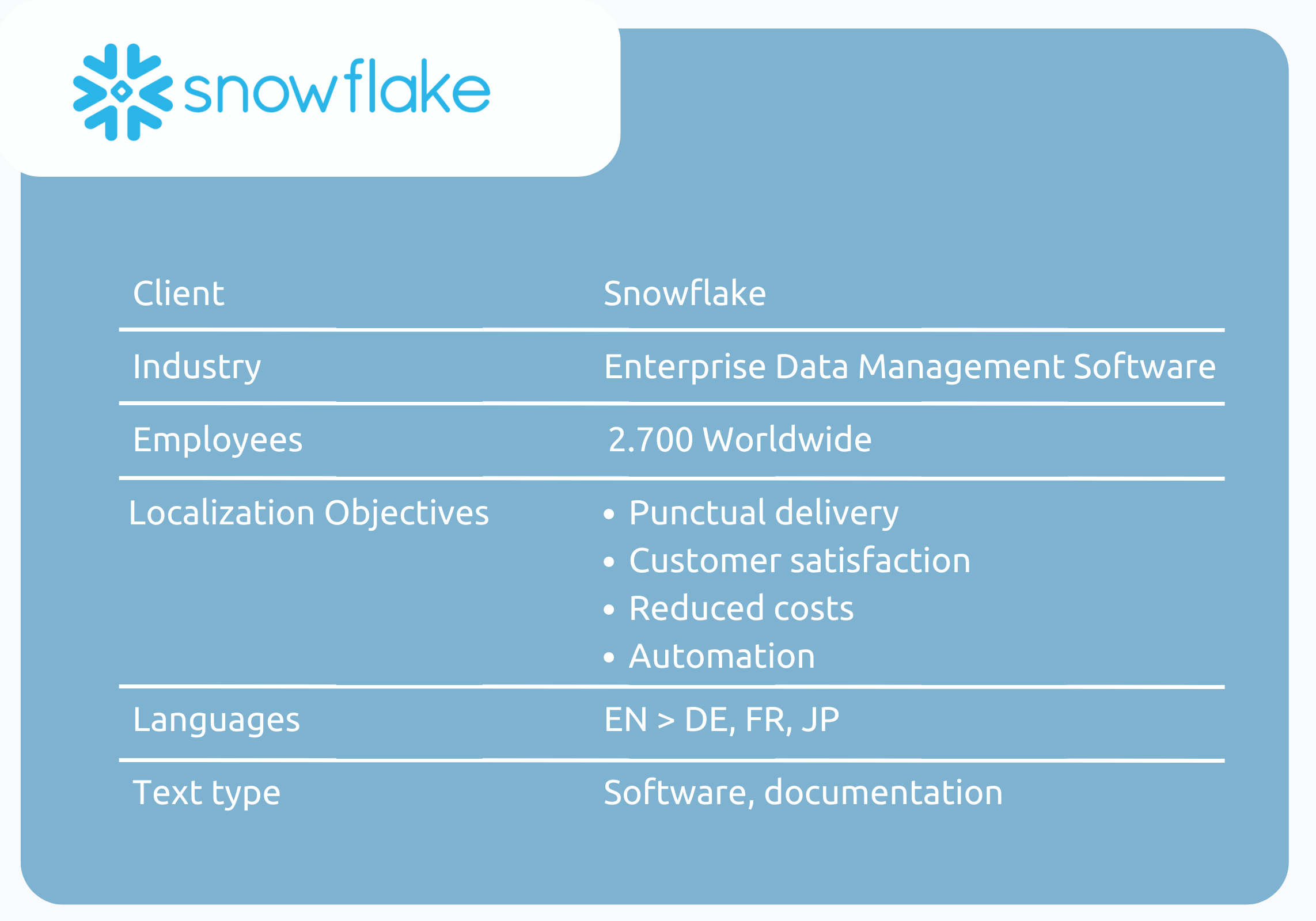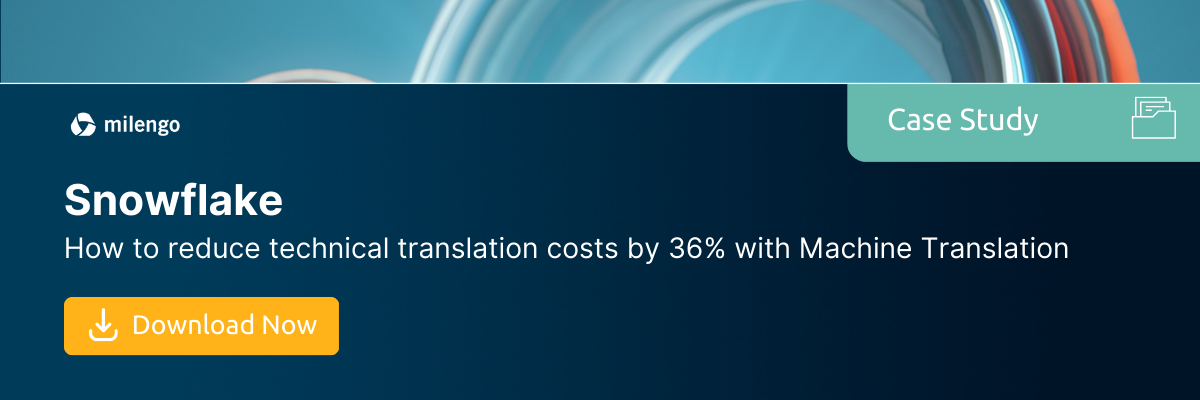Snowflake’s Technical Manual Translation Blueprint for Cost Reduction

Technical manual translation is akin to a map to help users navigate the waters of how to make the best use of your company’s product.
Users need information to understand the purpose and utility of a product. Whether it be a new machine, an updated piece of software, or their new IKEA shelf – technical documents such as user manuals hold treasures of information for our customer’s success and brand experience.
It’s common practice for technical documentation to come in multiple languages. However ensuring these guides and their translated counterparts are accurately written and up-to-date can be a time-sink, especially when your product teams are already working with tight release timelines.
With 30 years of experience in the localization industry, Milengo has helped Fortune 500 companies such as Infor and IBM seamlessly localize their enterprise software and translate technical manuals and user documentation.
This blog outlines an example of how our technical translation services helped one of the world’s leading Enterprise Data Management software providers, Snowflake, save 36% in translation costs and punctually deliver translations in line with their 1-week release cycles.
What is Technical Documentation?
Technical documentation extends beyond the standard end-user guide and manual. It encompasses documents relating to software architecture, design process, intended applications of products or software, and product roadmaps and plans.
Essentially technical documentation is any document that aims to explain the features and functionality of your product. It helps internal teams align and organize themselves during the product development cycle. For software companies, it empowers teams to achieve agile software development.
Watch this video for an explanation of the importance of technical documentation in software development.
There are two main types of technical documentation: product-based documentation and process-based documentation.
Product-based documentation
This type of documentation outlines what the product is supposed to be like and how it should function. Examples of product-based documentation include:
- Product Manuals
- User Guides
- Data Sheets
- API Documentation
- SDK Documentation
Process-based documentation
Process-based documentation outlines how the product should be built. This includes documents such as:
- Project plans
- Product roadmap
- Business standards
- Test schedules

Having well-written technical documentation available, and translated for your users in their native language, can help your company reduce spend on customer support, avoid legal pursuits, align internal teams, and save your customer’s sanity too!
However, for technical documentation to be useful, it needs to reflect the current state of your product. For products or software that encounter frequent updates, keeping translations of documentation up-to-date can become a time-consuming task for teams – especially if there are multiple languages to manage.
Goal-Driven Processes to Translate Technical Manuals & Software
Founded in California in 2012, Snowflake is a cloud-based Software-as-a-Service (SaaS) data warehouse that centralizes data for storage and analysis. Today they have over 2,700 employees and offices in 19 countries. Their claim to fame? A fast, flexible, and user-friendly platform that allows companies to unlock the full potential of their business data.
In 2018, Snowflake’s customer base tripled in size. To maintain this course of growth, the company decided to translate its products to expand beyond the boundaries of the English-speaking world. Their key requirements for success were:
- Punctual delivery: Snowflake publishes software updates in one-week cycles. To keep up with these seven-day sprints, translations of new features and accompanying documentation are needed to fit within these timelines. Any delays would have a knock-on effect for the entire release cycle.
- Consistently high-quality support: For SaaS providers like Snowflake, support and training are crucial for customers to leverage the software to its fullest potential. Their users rely heavily on high-quality technical support and regular documentation updates – both of which need to be provided in all the same languages as the solution.
- Low translation costs: Snowflake’s user documentation is hundreds of thousands of words in length – and increasing all the time. Maximizing the efficiency of the translation process was essential to prevent costs from spiralling out of control.

Start Small, and Build Your Blueprint for Scale
The partnership between Milengo and Snowflake began with a pilot project to demonstrate the cost savings machine translation (MT) could provide Snowflake for technical manual translation from English to French.
When this proved to work in harmony with Snowflake’s release cycle, the methodology was used to develop a specialized Machine Translation with Post-Editing (MT-PE) workflow with faster turnarounds and unparalleled low translation prices. This blueprint was then adopted for the German-speaking market.
We needed the highest quality translation in the shortest time possible. Machine translation with post-editing has exceeded all our expectations, while also reducing our costs.
– Yitzik Brenman, Sr. Manager, Documentation Snowflake
Nailing Tight Deadlines with Machine Translation
The rapid turnaround on Snowflake’s frequent release cycles posed a challenge. But with machine translation, Milengo held the key to greater speed and cost efficiency for localizing Snowflake’s user documentation. A two-pronged approach was decided upon for the translation process:
- Experienced human translators would handle the texts for the software itself, and all of Snowflake’s website and marketing content
- Machine Translations and standardized human Post-Editing would be employed for user documentation.
AI-First Translations
With the huge quantities of data Snowflake processes every day, automation and streamlined processes are a must. As such, speed and efficiency were essential in the company’s translation processes, as keeping up with its rapid release cycles would otherwise prove impossible. In response to this requirement, Milengo provided a rigorously tested machine translation system based on the latest developments in the field of artificial intelligence (AI) and neural networks.
Agile Software Development with Automated Translation Processes
Milengo’s localization experts went one step further in developing a highly automated system for Snowflake’s technical translation management process. This sped up the workflow and reduced manual file-handling efforts, which are prone to human error. The automation involved conceptualizing centralized systems and special file-preparation scripts to read and protect unique mark-ups accurately. Further details on the process automation can be found here.
Outcomes of Snowflake’s Software and Technical Manual Translation Blueprint
Snowflake’s unique software and technical manual translation blueprint yielded over 1 million words of translated text, and reduced the company’s translation costs by around 36%.
Needless to say, the company’s machine-translated user documentation has left the Silicon Valley company with satisfied customers and helped them hold their own in an incredibly competitive data warehousing space.
Machine translation works best when all the right pieces fit into place: choosing the right technology, professional preparation and post-editing of the translation files, technology management, quality assurance, and the use of properly trained and qualified post-editors. When all these boxes are checked, machine translation becomes a well-oiled machine – and with its certification in accordance with the international post-editing standard ISO 18587:2018. Milengo provides the perfect example of such a system.
Download the case study for full details.
Ready to see lower costs and quicker turnaround times on your technical manual translations? Milengo’s Machine Translation with Post-Editing produces accurate translations that reflect your company’s terminology and style. Ideal for technical content where linguistic precision and terminological accuracy matter most. Let’s get your free pilot project started.


